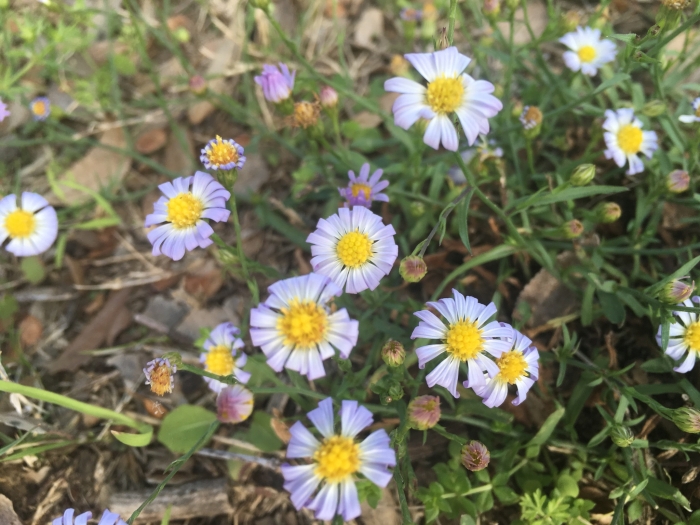Eastern Annual Saltmarsh Aster
(Symphyotrichum subulatum)
Eastern Annual Saltmarsh Aster (Symphyotrichum subulatum)
/
/

© Zinogre
CC BY-SA 4.0
Image By:
© Zinogre
Recorded By:
Copyright:
CC BY-SA 4.0
Copyright Notice:
Photo by: © Zinogre | License Type: CC BY-SA 4.0 | License URL: http://creativecommons.org/licenses/by-sa/4.0/ | Uploader: zinogre | Publisher: iNaturalist |















Estimated Native Range
Summary
Symphyotrichum subulatum, commonly known as Eastern Annual Saltmarsh Aster, is an annual herb native to a range of wetland habitats including coastal salt marshes, pond margins, sloughs, and riverbanks. Its native range extends from the eastern United States along the Gulf Coast to Texas, and it is also found in Mexico, the West Indies, Bermuda, Central America, and South America. This species typically reaches up to 3 feet tall, with erect stems and narrow, lanceolate leaves that are green to dark green in color. From late summer to fall, it produces an inflorescence consisting of a raceme with bright yellow disc florets surrounded by white to lavender ray florets, which are attractive to butterflies and native bees.
The Eastern Annual Saltmarsh Aster is valued for its ability to thrive in wet conditions and its contribution to wildlife habitat, particularly as a nectar source for pollinators. It is often used in restoration projects for wetland areas and can be planted in rain gardens or naturalized areas. Gardeners should provide moist to wet soil and full sun to part shade for optimal growth. While it is not known for significant disease or pest issues, it can self-seed prolifically under ideal conditions.CC BY-SA 4.0
The Eastern Annual Saltmarsh Aster is valued for its ability to thrive in wet conditions and its contribution to wildlife habitat, particularly as a nectar source for pollinators. It is often used in restoration projects for wetland areas and can be planted in rain gardens or naturalized areas. Gardeners should provide moist to wet soil and full sun to part shade for optimal growth. While it is not known for significant disease or pest issues, it can self-seed prolifically under ideal conditions.CC BY-SA 4.0
Plant Description
- Plant Type: Herb
- Height: 1-2 feet
- Width: 1-1.5 feet
- Growth Rate: Moderate, Rapid
- Flower Color: White
- Flowering Season: Summer, Fall
- Leaf Retention:
Growth Requirements
- Sun: Full Sun, Part Shade
- Water: Medium
- Drainage: Fast, Medium, Slow
Common Uses
Butterfly Garden, Erosion Control, Low Maintenance, Salt Tolerant, Street Planting
Natural Habitat
Native to wetland habitats including coastal salt marshes, pond margins, sloughs, and riverbanks
Other Names
Common Names: Baby’s Breath Aster, Annual Saltmarsh Or Eastern Annual Saltmarsh Aster, Eastern Annual Saltmarsh Aster, Saltmarsh Aster, Small Saltmarsh Aster, Wild Aster
Scientific Names: , Symphyotrichum subulatum, Aster exilis f. subalpinus, Aster exilis var. australis, Aster flexicaulis, Aster linifolius, Aster pauciflorus var. gracilis, Aster subulatus, Aster subulatus var. australis, Aster subulatus var. euroauster
GBIF Accepted Name: